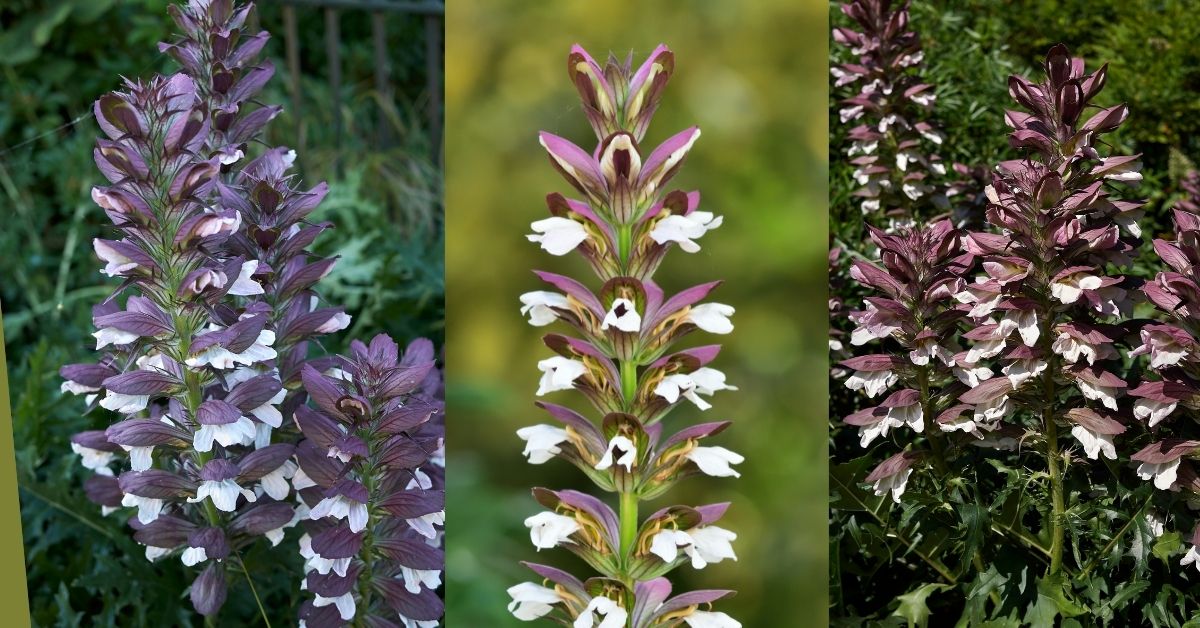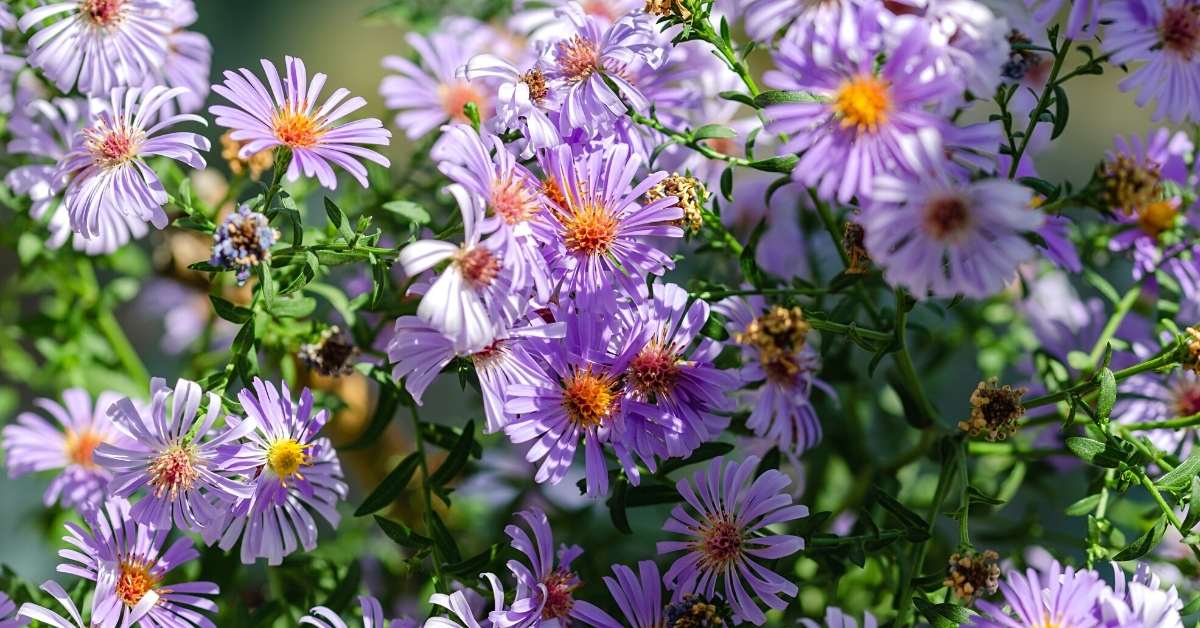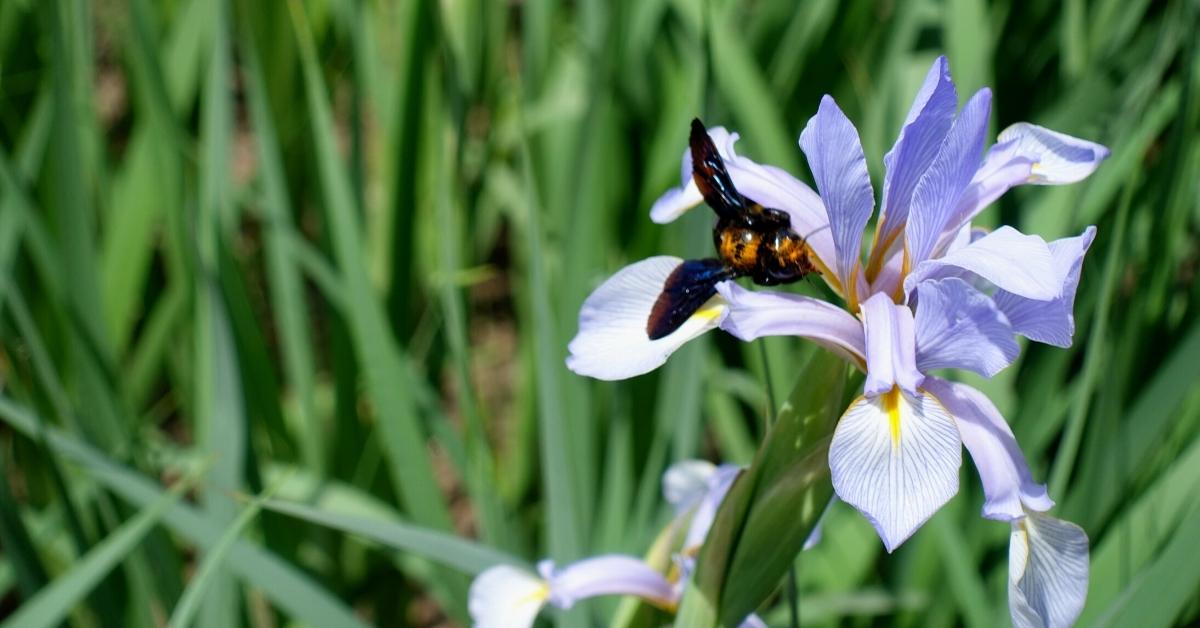This sprawling perennial delights with its outstanding splendor in midsummer. The Bear’s Breech (bot. Acanthus mollis) represents pure elegance with its delicate, creamy-white flowers. Its subtle play of colors provides refreshing variations in the colorful flower bed.
The medium-sized gems are cluster-shaped and appear from July to August. They contrast beautifully with the foliage, a rich dark green color. The individual leaves have a broad, lanceolate shape and are lobed. Their smooth surface is wonderfully shiny.
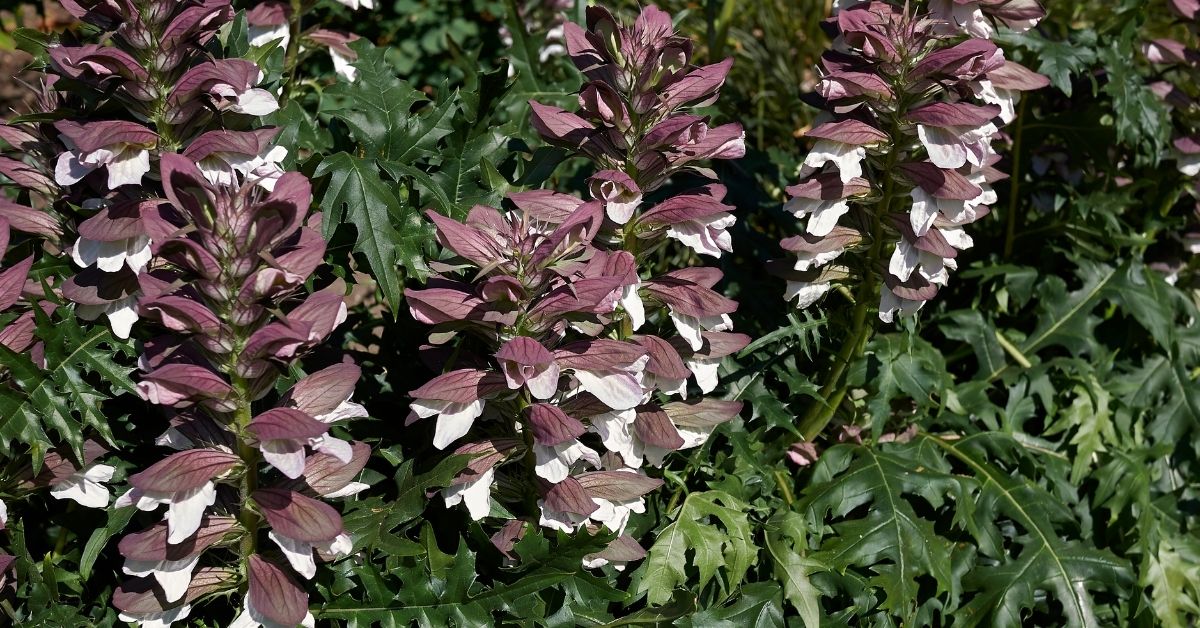
The growth of the perennial is upright to slightly curved. Especially in the lower area, the plant unfolds slightly more protruding due to the juicy foliage. The Bear’s Breech reaches a height of up to 60 inches and a width of 40 inches.
These properties must be taken into account when creating a group of plants. In small tuffs, with a maximum of five specimens, a planting distance of 30 to 50 inches (80-100 centimeters) must be maintained. This corresponds to two plants per 10 ft2 or 1 m2.
The Acanthus mollis has enough space to develop optimally and show its splendor. It is also a feast for the eyes combined with other bed companions or planted individually. The gardener likes to use them to loosen up large open spaces in stone structures or near the edges of trees.
A sunny place with loamy-sandy and nutrient-rich soil should be chosen as the location. The Bear’s Breech is a real child of the sun. It thrives optimally with many hours of sunshine and requires little maintenance. This elegant perennial prefers a dry substrate.
The gardener avoids waterlogging as far as possible, as this damages the roots and causes the plant to die. The cold season does not pose any problems for Acanthus mollis. Specimens planted outdoors overwinter in the ground without special protection.
However, it is advisable to overwinter plants kept in buckets and pots in a protected place. The basement, attic, garage, and other unheated rooms are ideal for this.
Since ancient times, the Bear’s Breech has been known as a medicinal plant. The root of the beautiful perennial plant helps with burns and dislocated limbs. A healing effect is also known for diarrhea and cramps. In addition to its beautiful appearance, this plant has practical use and is a true all-around talent that should not be missing anywhere.
The pretty flower decoration is an attractive and popular cut flower. It gives gorgeous bouquets of flowers the finishing touch and creates an inspiring sight in the vase in the living room. The delicate elegance of the wonderful plant delights the viewer in every imaginable place.
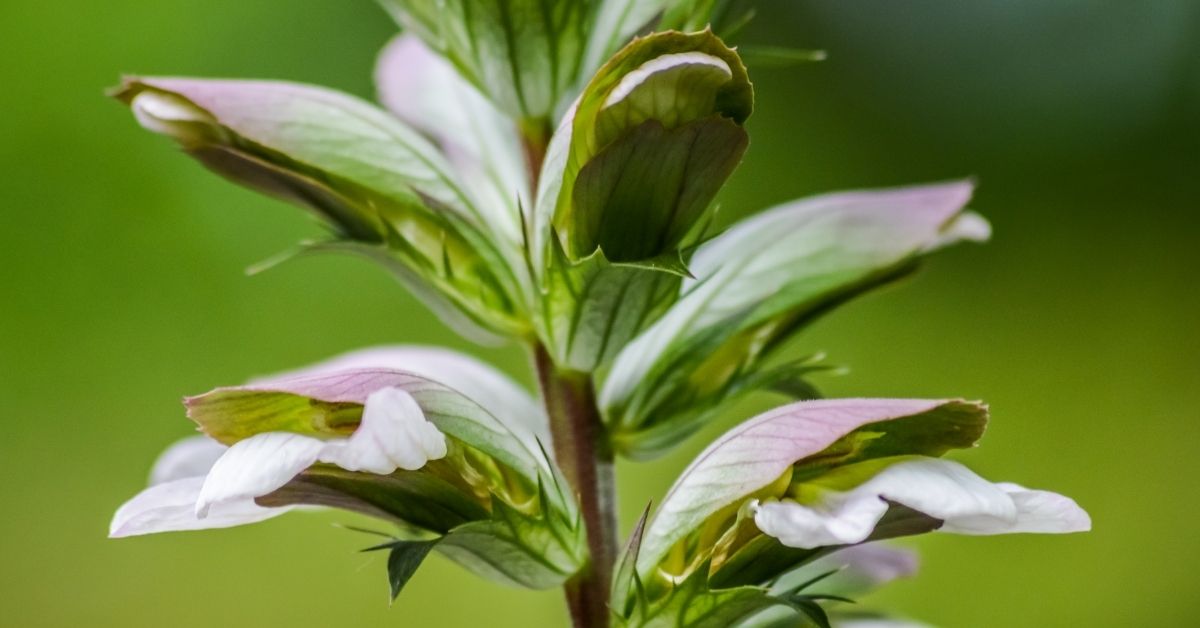
Bear’s Breech Origin
Acanthus mollis belongs to a genus with about 25 species scattered in the Mediterranean region, Near East, and Africa. The Bear’s Breech grows wild in stony terrain between trees and shrubs in the Mediterranean region.
The only partially winter-hardy species has been cultivated in Central Europe for a long time. There are now selections that do well in our climate. The perennial is related to the Spiny bear’s Breech (Acanthus spinosus) but has nothing to do with the invasive giant hogweed (Heracleum mantegazzianum)!
Growth
The Bear’s Breech is a perennial that forms powerful clumps. It grows between 30-50 inches (80 and 120 cm) high, depending on the variety. The long flower stalks arise from a basal rosette of leaves.
Leaves
The extravagantly shaped leaves of Bear’s Breech are also familiar to art historians: they served as models for the capitals of Greek columns or decorated friezes. The pinnate, leathery leaves of the plant are basal. They are obovate and dark green; they shine on the upper side.
Blossoms
The flower clusters are up to 40 inches long and stand on a purple-tinged stalk. The basic white, lip-shaped individual flowers of the plants often sit under differently colored bracts.
Fruit
The flowers of Acanthus mollis develop into capsule fruits.
Location
Bear’s Breech likes to be in full sun and well-drained in the garden; dryness is not a problem. Above all, non-green representatives can also cope with penumbra. The perennials only reliably survive the winter in regions with mild winters. Planting out over the winter is unavoidable, especially in the event of a frost.
Soil requirements
Although the soft hogweed often grows on poor soil in nature, it is a heavy feeder: the plant can only flower reliably if there is a good supply of nutrients.
Planting Acanthus mollis
To avoid rotten roots and overwintering, it is best to plant the Bear’s Breech early spring. Adding sand can reduce the problem of waterlogging. Please allow enough space for the perennials to develop!
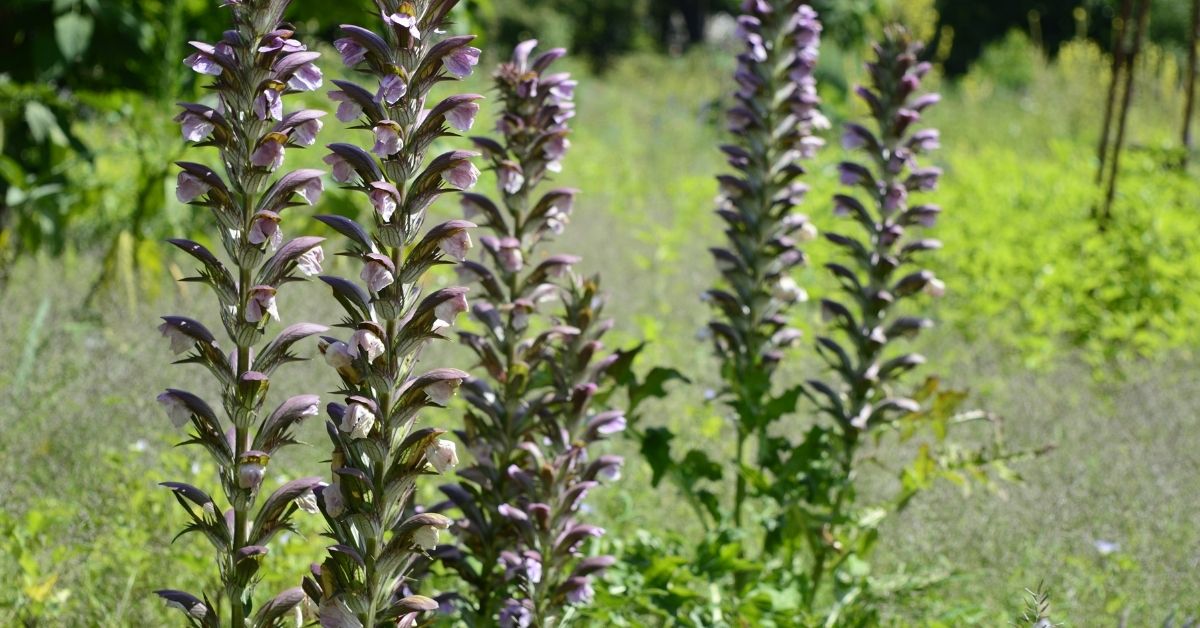
Care
The distinctive infructescence of Acanthus mollis should be left over the winter. A compost addition in the spring provides the necessary nutrients for the Bear’s Breech.
Acanthus are perennial herbaceous plants native to the Mediterranean, making for stunning architectural plants. Still, they are also invasive garden ‘thugs’ with unpleasant prickles even on their flower spikes. As a result, we frequently place them in dark corners, garbage dumps, or to hide anything unsightly. This may seem unjust, yet it is entirely reasonable. In reality, it’s just what you need to keep an intruder away from your garden’s edge.
How to kill and get rid of Acanthus mollis?
Acanthus mollis and Acanthus spinosus are only entirely dormant in our area during the winter. Cutting them back to the ground in the fall does not prevent them from growing again from their fleshy roots. If you become tired of this spreading thug and try to dig it out, don’t expect the roots to reshoot and infest your compost heap, as they have on ours in numerous places.
Every fleshy root must be thrown into the fire to achieve containment or elimination. Despite its unquestionable qualities, I am not a lover of this plant, especially as a dried flower when the 3-4ft long flower spikes with their purple-tinted bracts and stalks are cut and dried just before the blooms appear.
Although it’s difficult to picture anyone wishing to let this plant expand much farther than it already has, the roots will reshoot when dug up and sliced up into virtually any size. It grows in a wide range of conditions, including poor and rich soils, shade, and full sun.
The reference books advocate growing it on a ‘spacious’ border. We advocate launching it at a landfill, where its intrusiveness will cause little significant harm. Once a year, slash it to the bone and revel in the joy!
Split
Acanthus mollis is divided with a spade in the spring – please do not cut it into small parts!
Winter protection
Winter protection is a must, especially for young plants!
Use
Individually or in groups, Acanthus mollis are best displayed in front of a darker backdrop. Bear’s Breech fits well in a gravel bed, in an open space, or on the edge of a wooded area in the sun. Varieties that seek some shade are set aside with Lenten roses; sun-loving types go well with astilbes or hostas. The Bear’s Breech is also pretty in this combination as a vase decoration!
Variations
A distinction is made between two subspecies: the subspecies latifolius occurs in the west, and the subspecies Mollis is found in the east. The latter group includes the ‘Rue Ledan’ variety, which is hardier than the species and can also score points for its abundance of flowers: the long candles of the plant are covered with white flowers that change slightly to pink.
The variety is also sold under the names ‘Jeff Albus’ and ‘Jefalba’. Deep yellow leaves characterize the cultivar ‘Hollard’s Gold’. It is better not to expose them to the full sun since necrosis often occurs. The leaves of ‘Tasmanian Angel’ are variegated. In this variety, the leaf blades are whitish-yellow when they shoot. The pink flowers go nicely with it. The foliage of the ‘Whitewater’ variety looks flamed.
Propagation
The species can be propagated by sowing, the varieties by dividing the rootstock or root cuttings. For this purpose, one proceeds with all methods, as with the (Acanthus hungaricus).
How to grow acanthus mollis from seeds?
Acanthus clumps grow slowly. In the fall or spring, cut off pieces of rootstock with visible leaf buds to split them. Root cuttings collected in late fall or early winter can also be cultivated; plant three-inch long root portions vertically in a cutting mix.
Soak ripe acanthus seeds in water for a day or two before planting one-quarter-inch deep in a seed mix and growing at 50-55°F. In twenty-one to twenty-five days, they usually sprout. It will take two or more years for seedlings to reach blooming size.
Diseases and pests
Unfortunately, especially young specimens of Acanthus mollis are good food for snails. Therefore, many gardeners initially rely on pot culture and first plant out the adult perennials.
